The Sustainable Clothing Action Plan - 2012-2019 Progress Report
The Sustainable Clothing Action Plan (SCAP) was a groundbreaking collaborative framework designed to reduce the environmental footprint of clothing in the UK. Led by the Waste and Resources Action Programme (WRAP), signatories made a commitment to reduce the water, waste, and carbon impacts of the clothing they sold.
What exactly does SCAP do?
Besides radically reducing carbon, water and waste impact of the UK clothing and textiles industry, SCAP signatories and supporters were brought under this commitment to rally against the environmental costs and impacts of clothing consumed. As such, by 2020, 90 organisations, including brands & retailers representing more than 48% of UK clothing sales volume, made the voluntary SCAP Commitment to collectively reduce the footprint of carbon, water and waste to landfill by 15%, and reduce waste arising by 3.5%, relative to a 2012 baseline.
The SCAP Framework
In order to aid the signatories, SCAP came up with the following collaborative framework:
-
SCAP Footprint Calculator to measure impacts of all products sold and tracking changes over time
-
Making changes in fibre & fabric selection that reduce the environmental footprint of clothing products
-
Working with supply chain partners to reduce the environmental impact of manufacturing processes
-
Extending the useful life of clothes and reducing the impact of clothing in use through product design & services
-
Using effective messaging to influence consumer behaviours to reduce environmental impacts from clothing
-
Increasing re-use & recycling to recover maximum value from used clothing
-
Developing actions to keep clothing out of landfill
SCAP Achievements
By the end of 2019, SCAP signatories and supporters exceeded carbon and water footprint targets, with a 15.9% and 19.5% reduction respectively. A reduction in waste just fell short of the 3.5% reduction, with -2.3% reported. Whilst 4% out of the 15% target reduction in clothing household waste was met, representing slower progress on textile waste.
As SCAP reaches its endpoint, momentum continues in the actions of its signatory organisations, the heightened awareness of clothing consumers, robust evidence for the most impactful interventions, and businesses’ ability to measure greenhouse gas emissions and water footprints.
Importantly, SCAP provides knowledge and impetus for UK-focused action in the next 10 years in WRAP’s new voluntary agreement: Textiles 2030. With an official launch date of April 2021, Textiles 2030 will be the most ambitious national voluntary agreement for clothing and other textiles in the world. The ten-year programme aims to transform UK clothing and home fabrics to reduce their impact on climate change. In this way, Textiles 2030 aims to reduce lifecycle GHG emissions in line with the global goal of a 1.5°C trajectory, cut the water footprint of products and deliver a UK-wide circular textiles road map.
Further Information
This report for the period 2012 - 2019 outlines how WRAP’s pioneering industry led action plan, SCAP, has delivered positive environmental and economic outcomes for forward-looking UK fashion and textiles organisations at all levels of the industry. It highlights examples of best practice, describes the impact of some of the signatory actions, and the ‘SCAP legacy’. Finally, it considers how to take the learning from SCAP forward into the 2020s and the next steps for UK fashion and textiles.
Read the full report here: SCAP 2020 Final Report
External source(s)






